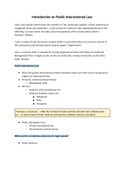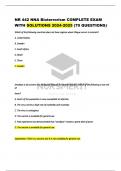Introduction to Public International Law
Law is that element which binds the members of the community together in their adherence to
recognized values and standards (...) Law consists of a series of rules regulating behaviour and
reflecting, to some extent, the ideas and preoccupations of the society within which it
functions” (Shaw)
“Law is a body of rules for human conduct within a community which, by common consent of
this community, shall be enforced by external power” (Oppenheim)
Law is a coercive order. It provides for socially organised sanctions and these can clearly be
distinguished from a religious order on the one hand and a merely moral order on the other
hand” (Kelsen)
Public International Law
● Rules that govern international relations between states and other actors recognized as
subjects of international law
● Primarily: relations between States
○ Westphalian order
● But also:
○ Relations with and between IOs
○ Relations between States and
■ Individuals
■ TNCs
■ Insurgents
That law is concerned…. With the ‘conduct of states and IOs and with their relations inter
se… as well as some of their relations with persons, whether natural or juridical”
● Public, distinguish from:
○ Private international law
○ International commercial law
What are the constitutive elements of a legal system?
● Social construct
, ● That consists of rules
● Competing notions that international law is a sort of discourse that provides rules, but
also a way for states to communicate with each other…
Critical views against PIL as a legal system
● Somewhat of a primitive system
● No compulsory enforcement, hence no binding effect (Morgenthau)
○ If you cannot enforce, what use?
● No obligatory international adjudication, i.e. courts with compulsory jurisdiction
○ Even ICJ depends on States accepting its jurisdiction
● Limited number of rules
○ Does not regulate everything; gaps
● International relations vs International law: International law only as a result of
international politics
● International law as a western/eurocentric concept
○ Does it really represent world views?
○ I.e. colonialism
Possible arguments in favour of seeing it as a legal system
● States do feel bound:
○ Distinguish between binding and non-binding instruments
○ Justify non-compliance in terms of the law
■ Many times make reference to law, but when countries do not comply,
call for an exception of this law
● International law is not just the vocabulary, but the underlying grammar of international
relations
○ What created the level playing field
○ Foundation for regulating international relations
● International inter-dependence
○ Reciprocity
● Net of rules constantly narrowing
○ There are gaps but at the same time international law has developed enormously
over the past decade
○ More in the implementation phase
○ So many rules that there is another problem: fragmentation
○ Very developed system with several sub quarters
, ● Enforcement comes in many forms
○ Economic sanctions
○ Treaties often include compliance provisions
Louis Henkin: “Almost all nations observe almost principles of international and almost all of
their obligations almost all of the time”
Comparison to domestic order
● Less clarity about rules
○ Rules sometimes not codified (CIL)
○ Rules can apply to some States but not to others
● Enforcement: decentralized and sometimes primitive
● No executive: horizontal relationship between sovereign states
Basis for obligations under PIL
● Natural v positivist approach
○ Natural law approach: law above States
■ Natural law is present, ie. The Martens Clause: concept of public
conscience in the law of armed conflict
○ Positivist approach: law between States
■ Majority view
■ Law is something made between States; international law consists on
these laws that States have consented to
Purposes of PIL as a legal order
● PIL seeks to realise particular objectives → peace, justice…
○ But what do we understand by these concepts?
● Law of co-existence
● Law of cooperation
○ I.e. international human rights
● Law of globalization
○ Ultimately about human beings
○ Reorientation from state-centric conception
, PIL Reading 1
The Nature and Development of International Law
● Law is that element which binds the members of the community together in their
adherence to recognised values and standards.
○ It is both permissive in allowing individuals to establish their own legal relations
with rights and duties, as in the creation of contracts, and coercive, as it punishes
those who infringe its regulations.
○ Law consists of a series of rules regulating behaviour, and reflecting, to some
extent, the ideas and preoccupations of the society within which it functions.
● And so it is with what is termed international law, with the important difference that the
principal subjects of international law are nation-states, not individual citizens.
○ There are many contrasts between the law within a country (municipal law) and
the law that operates outside and between states, international organisations
and, in certain cases, individuals.
● International law itself is divided into conflict of laws (or private international law as it is
sometimes called) and public international law (usually just termed international law).
● Similarly, the mistake of confusing international law with international morality must be
avoided.
○ While they may meet at certain points, the former discipline is a legal one both
as regards its content and its form, while the concept of international morality is
a branch of ethics.
○ This does not mean, however, that international law can be divorced from its
values.
● Without a legislature, judiciary and executive, it would seem that one cannot talk about
a legal order. And international law does not fit this model. International law has no
legislature.
○ The General Assembly of the United Nations comprising delegates from all the
member states exists, but its resolutions are not legally binding save for certain
of the organs of the United Nations for certain purposes. There is no system of
courts. The International Court of Justice does exist at TheHague but it can only
decide cases when both sides agree and it cannot ensure that its decisions are
complied with. Above all there is no executive or governing entity. The Security
Council of the United Nations, which was intended to have such a role in a sense,
has at times been effectively constrained by the veto power of the five
permanent members (USA; USSR, now the Russian Federation; China; France;
and the United Kingdom).










